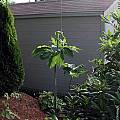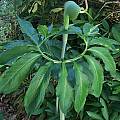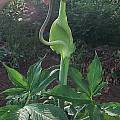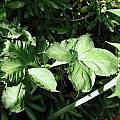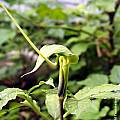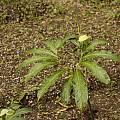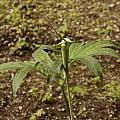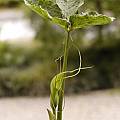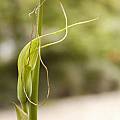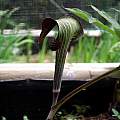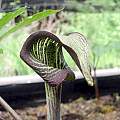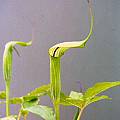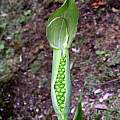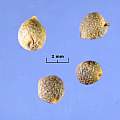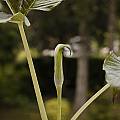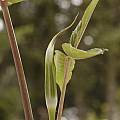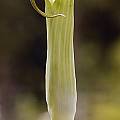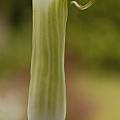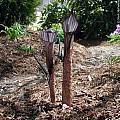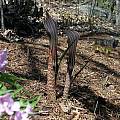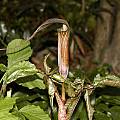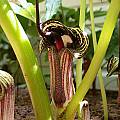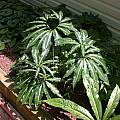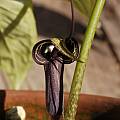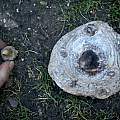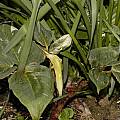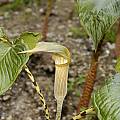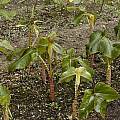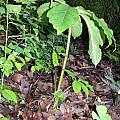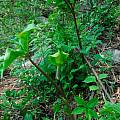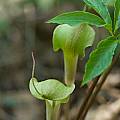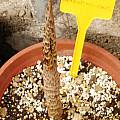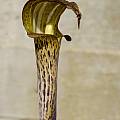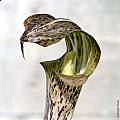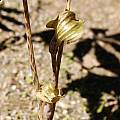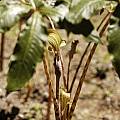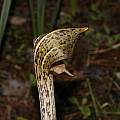Arisaema species h-n are found on this page
Arisaema a-c - Arisaema d-g - Arisaema o-s - Arisaema t-z - Arisaema index
Arisaema heterophyllum Blume is native to China and temperate east Asia. It doesn't emerge until mid June, then in a short period of just 2 weeks the plant grows to 5 ft (150 cm) tall to the top of the spadix. The first two pictures are of the whole plant, July 18, 2002. The next two are leaf photos taken July 2002. The first is a good view of the heterophyllous leaf, e.g. the leaf of the non-flowering shoot which is rather different, with broader, more ovate, deeply crinkled leaves with much fewer segments. All photos from Mark McDonough.
A smaller edition of Mark's plant grown by Arnold Trachtenberg is shown below.
Here is a plant that shows its distinctive horse-shoe leaf and a twisted spadix. Photos by Giorgio Pozzi May 2006. These tubers came from Chen nursery by mistake in a mix with A. lobatum, A. serratum and A. amurense as A.60. They both have a twisted spadix.
Arisaema intermedium Blume is a medium size plant, having a green spathe with light veins and a very long spadix appendage over the trifoliate cordate leaf. Height range: 40-60 cm. Grown and photographed by Giorgio Pozzi, May 2006.
Arisaema iyoanum Makino is native to damp forests and streamsides on the Japanese islands of Shikoku and Honshu. A. iyoanum carries its long-canopied spathe above a tall, mottled pseudostem under one or two leaves which are divided into 9-17 leaflets. The form that is pictured here is sometimes called var. nakaianum, however Gusman & Gusman point out that in its native habitat it grows amid the typical, paler form and that the color forms also vary in the number of leaflets, thus "the validity of its varietal status must be questioned." Grows to about 120 cm (48 in). Photos and text from Paige Woodward.
Arisaema jacquemontii Blume is native from Afghanistan to Tibet and grows to 70 cm (28 in). It is described by Paige Woodward as a plant of El Greco-esque proportions with a deep, narrow bright green with white stripes spathe, a hood that rises up instead of curving down, and ends in a long whip, a spadix with a long and purple-black or green whip, and multi-fingered leaves. She recommends growing it in moist soil, in part shade and says it is hardy to zone 6. The first photo is from Rob Hamilton. The second is from Paige Woodward. The third is from David Pilling.
Arisaema jinshajiangense H.Peng & H.Li is a medium size plant from Yunnan with a green spathe with white veins and a white area at the base and another white spot at the throat level. It usually has two trifoliolate leaves and flowers late May to June here in Italy. Height range: about to 30 cm. Grown and photographed by Giorgio Pozzi, May 2006.
Arisaema kishidae Makino ex Nakai is native to Japan. Height range: 1-2 ft.The first three photos were taken by Mark McDonough, April 25, 2004 and show three views of this remarkable species with odd translucent coppery brown spathes, veined whitish, colored near black-brown from the exterior. The flowers appear before the foliage. The leaves are dark, near black upon emerging, and are green and silvery veined when expanded. The last is a picture of the spathe well developed before the leaves unfold, photo by Giorgio Pozzi, April 2007.
Arisaema kiushianum Makino is perhaps the 'cutest' of the arisaemas, growing to only about a foot with owlish little striped "flowers", held very close to the ground with a multicolored spathe, slightly hooded and with a spadix appendage that sticks upward out of the spathe. It blooms in early summer and is from Japan. The first two photos were taken by John Lonsdale. Photo 3 is another closeup of the spathe with the typical T-shaped spot inside visible; photo by Giorgio Pozzi, May 2006. Photo 4 by Pontus Wallstén compares two flowering sized arisaema tubers, showing the huge variation in size found in this genus; to the left, Arisaema kiushinianum and to the right, Arisaema griffithii from India.
Arisaema lobatum Engl. is a Chinese species with variable features (spathe, leaf colors and sizes). Height range: 1-2 ft. Photos by Giorgio Pozzi, April 2007. The first photo shows a medium size plant with a yellowish-orange spathe and leaves with white and black spots, the second a green orange spathe, plain green leaves and mottled stem, and the third a clump in cultivation.
Arisaema macrospathum Benth. is one of only three species of Arisaema found in Mexico. The other species are Arisaema triphyllum and Arisaema dracontium whose distribution ranges also includes the United States. It is a relatively common plant in oak and pine-oak temperate forests. The flowers appear in April-May just before the foliage starts to emerge. The leaf is similar to those of other Arisaema species but can be quite robust with some petioles reaching close to a meter in height. The most distinctive characteristic about the "flower" is the extraordinarily long spadix that sticks out of the inflorescence like a tongue. Local people call it "cola de caballo" which translated means "horse's tail". Height range: 2-3 ft. Photos by Dennis Szeszko photographed in-situ in Mexico State.
Arisaema murrayi (J.Graham) Hook. Known as Murray’s Cobra Lily, this herbaceous monocot produces a striking spathe and a compact corm, with elliptic to lanceolate leaflets. It typically inhabits shaded forest slopes and rocky outcrops of the Western Ghats in India. Photograph by Saket Shrotri.
Arisaema nepenthoides (Wall.) Mart. is a tall plant with palmate leaves and tannish colored, eared flowers (having auricles). It also has attractive, darkly spotted 'stems'. It grows to about a meter tall. Flowers are variable among the various forms. This species is synonymous with Arisaema ochraceum Schott. The first photo below pictures one grown and photographed by Rob Hamilton. The next three photos taken March 2006 by Giorgio Pozzi show a plant that came from Ganesh Mani Pradhan nursery (INDIA). The first picture is of the stem, the second picture shows the spathe, and finally there is a close-up.
Guy Gusman writes in his book this species is very variable in the spathe's characters, one year with evident auricles, one year without auricles. Here is a specimen with a double spathe. Looking opposite, the upper is female. The lower male, similar in colour and shape, is ruined by the two stems; the upper by a strong wind before I took the pictures. This tuber also came from Pradhan nursery this autumn and I don't know if this is a settled character. The third photo taken in April 2007 shows the pointed auricles of this specimen. Photos by Giorgio Pozzi.
Arisaema a-c - Arisaema d-g - Arisaema o-s - Arisaema t-z - Arisaema index
